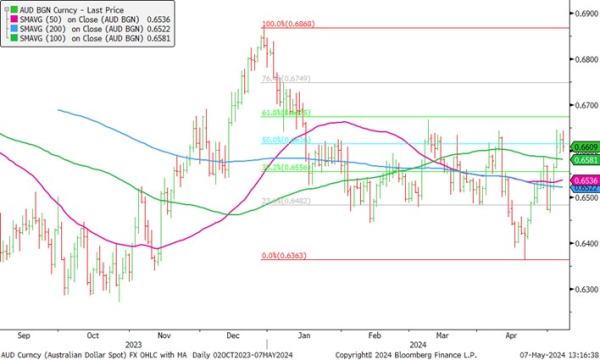AUD: RBA fails to meet the hawkish expectations
Key points:
- The Reserve Bank of Australia left the cash rate at 4.35%, as expected
- RBA maintained a neutral and data-dependent approach and fell short of market’s high hawkish bar
- While the market expectations for the RBA could be prone to dovish repricing, AUDUSD could be supported by a weaker USD given Fed’s dovish posturing
- China’s stability and gains in commodities could also keep AUD range-bound
The Reserve Bank of Australia (RBA) left the cash rate unchanged at 4.35%, as expected. The market had set a high hawkish bar for the central bank, with pricing suggesting significant odds of a rate hike this year. As anticipated, the RBA did not meet this high bar, leaving the door open for both rate hikes and rate cuts without showing any significant concern over the recent uptick in Q1 inflation.
While the RBA changed its language to highlight upside risks to inflation, it also stressed risks to consumer demand from high inflation and high interest rates. Overall, the posturing remained neutral and data-dependent. This reaffirms that the bar for rate hikes is high, and markets will be forced to adjust their interest rate expectations if inflation does not continue to rise from here. This could lead to a dovish repricing in the RBA rate expectations path.
Still, the RBA will likely remain the laggard among G10 countries to cut rates. Therefore, AUD traders will need to focus more on US data and Fed signaling than domestic data. The recovery in China and commodity prices will also continue to play a key role in determining AUD's direction from here.
If US data weakens further, the dovish repricing in the Fed could be faster than that of the RBA. Consequently, despite the lack of a push higher in AUD due to the RBA missing the hawkish bar, there is also little reason to expect a sharp slide lower, suggesting AUDUSD could remain locked in a range for now.
AUDUSD faces a test of its 200DMA at 0.6522, which could provide support for this week. On the upside, key levels to watch are the psychological barrier of 0.67 and the December high of 0.6871.
AUDNZD reversed below 1.10. Given that Australia’s inflation is lower than NZ’s Q1 inflation, and market pricing for RBNZ is relatively more dovish, there could be a risk of further downside for the cross.
There is no significant data out this week from the US or Australia. Focus remains on Fed speakers, but the risk of a stark dovish Fed repricing is unlikely until inflation data, out on May 15, shows some cooling.

-----------------------------------------------------------------------
Other recent Macro/FX articles:
7 May: Global Market Quick Take - Asia
3 May: JPY: Staying on intervention alert
2 May: Fed Decision: High-for-longer, not higher-for-longer
30 Apr: AUD: Retail sales miss questions RBA market pricing
30 Apr: FOMC rate decision: How to trade the event
29 Apr: Weekly FX Chartbook: Fed’s hawkishness meets BOJ’s dovishness
29 Apr: Macro Podcast: Japanese drama - what's next for the yen?
26 Apr: JPY: Bank of Japan adds to reasons to stay bearish yen
25 Apr: JPY: Accelerated sell-off; can the BOJ halt yen's decline?
25 Apr: Thematic Podcast: Deciphering Asian forex interventions
23 Apr: GBP: What can drive the next leg lower?
22 Apr: Weekly FX Chartbook: Stretched USD strength is raising intervention alert
19 Apr: FX 101: Using FX for portfolio diversification
18 Apr: JPY: Intervention alert, or a BOJ alert?
16 Apr: Chinese Yuan’s Double Whammy - Dollar Strength and Yen Weakness
12 Apr: Riding the Fed-ECB Policy Divergence
11 Apr: ECB rate decision: How to trade the event
9 Apr: CAD vulnerable as market underprices dovish Bank of Canada risks
9 Apr: US inflation report: How to trade the event
8 Apr: Macro and FX Podcast: NFP, CPI, ECB and Japan
3 Apr: Chinese yuan bears are undeterred by PBoC’s grip
3 Apr: FX Quarterly Outlook: The rate cut race shifts into high gear
8 Feb: FX 101: USD Smile and portfolio impacts from King Dolla